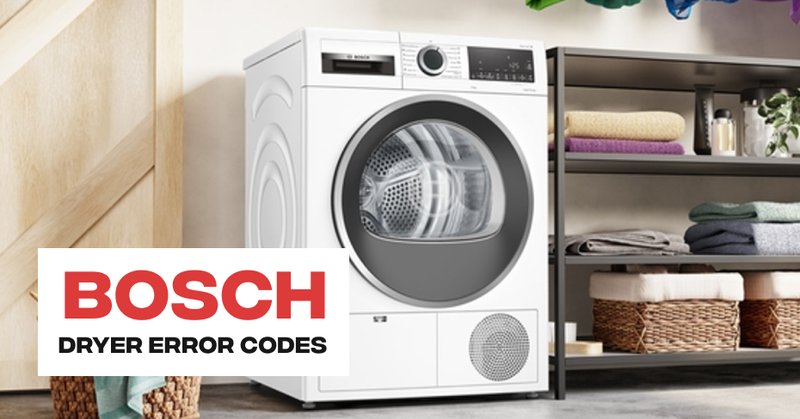
You might be wondering why this error occurs. It’s often due to obstructions or mechanical wear that prevent the drum from turning freely. Just as a pebble in a shoe can make walking uncomfortable, even a small issue in your dryer’s mechanism can hinder its performance. The good news is, with some preventative care, you can often avoid the E3 error entirely. Let’s dive into the specifics and explore how you can keep your Bosch dryer running smoothly with some straightforward tips.
Understanding the Bosch Dryer E3 Error Code
The first step in preventing the E3 error code is understanding what it means. In simple terms, E3 typically signals that the motor is having trouble turning the drum. Imagine if you were trying to spin a merry-go-round, but there was something stuck underneath. That’s similar to what might be happening in your dryer. This obstruction could be from clothing, a foreign object, or even a buildup of lint or debris.
How does this error manifest? You might notice that your dryer isn’t spinning at all or that it stops mid-cycle. This can be frustrating, especially when you’re relying on it for fresh, dry clothes. However, knowing that the E3 code relates to drum movement gives you a clear starting point for troubleshooting. Often, resolving this involves a simple check and cleaning process that you can perform without professional help.
Next, think about what could block the drum. Overloading the dryer is a common culprit. It’s like trying to carry too many groceries in one trip—you might drop something or not make it to your destination. Similarly, if the drum is too full, it might not rotate as it should. Therefore, understanding the capacity and limitations of your Bosch dryer is crucial in preventing the E3 error code from popping up.
Routine Maintenance to Prevent E3 Errors
Here’s the deal: regular maintenance is your best defense against the E3 error. Just as regular oil changes keep your car running smoothly, periodic checks and cleaning help your dryer perform optimally. Start by ensuring that you’re not overloading the dryer. This means always leaving enough room for clothes to tumble freely, which not only prevents errors but also dries clothes more evenly.
Another important task is cleaning the lint filter after each use. Think of it as letting out a bit of air from an inflated balloon. If the lint traps are full, it’s harder for the air to flow, thus straining the motor and leading to potential errors. Make it a habit to clear the filter, and while you’re at it, regularly check the venting system for any lint buildup that might obstruct airflow.
Moreover, inspect the drum for any signs of wear or blockage. Look for any foreign objects that might have slipped through pockets and gotten lodged in the drum area. Keeping the inside of your dryer free from obstructions is like keeping your garden free of weeds – it prevents small problems from becoming big headaches. With these routine checks, you’ll catch potential issues early and keep the E3 error at bay.
Addressing Mechanical Issues in Your Dryer
Sometimes, preventing the E3 error requires addressing specific mechanical issues. If your dryer is older, worn-out parts could be to blame. Just like how an old wristwatch might tick slower over time, your dryer’s components can wear out and lose efficiency. If you suspect this is the case, inspecting and possibly replacing parts like the drive belt or motor might be necessary.
When performing these checks, ensure the dryer is turned off and unplugged for safety. You’ll want to look at the drive belt first – is it intact or frayed? If it’s worn out, replacing it could restore your dryer’s functionality. Similarly, listen for unusual noises during operation. They’re like warning bells that something isn’t working as it should. A rattling or squealing sound might indicate that the motor bearings are worn and need attention.
While more involved than routine cleaning, addressing these mechanical aspects can significantly improve your dryer’s performance. If the thought of handling these repairs feels overwhelming, don’t hesitate to consult a professional. Their expertise can save you time and potential frustration, ensuring that your dryer stays in top shape.
Preventative Tips to Keep Your Dryer Running Smoothly
Now, for some parting advice: prevention is the key to avoiding the dreaded E3 error in the future. Start by familiarizing yourself with the user manual. It’s like a roadmap specifically for your dryer, outlining capacity limits and maintenance tips to keep everything running smoothly. Knowledge of these guidelines can empower you to use your dryer confidently and effectively.
Additionally, consider the placement of your dryer. Make sure it’s on a level surface to avoid unnecessary strain on the motor. It’s a bit like ensuring your washing machine doesn’t rock during a spin cycle. An uneven surface can lead to excessive vibration and wear over time. Check the balance and make adjustments if needed—small tweaks here can prevent bigger issues down the line.
Finally, create a regular maintenance schedule. Just like you’d schedule a workout or a meal prep session, dedicate time to check up on your dryer. Monthly cleanings of the lint trap and bi-annual inspections of the vent and drum should suffice to keep your machine happy. With these proactive measures, you’ll not only prevent error codes but also enjoy a more efficient, reliable appliance for years to come.
Incorporating these tips and practices into your routine will help ensure that your Bosch dryer remains a dependable part of your household chores, free from the hassle of unexpected error codes.